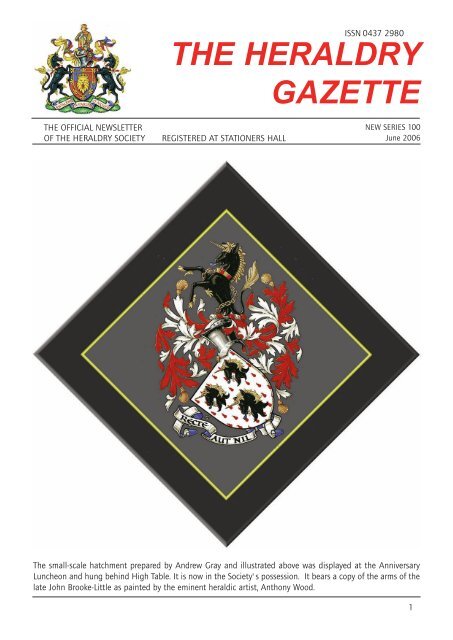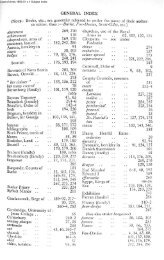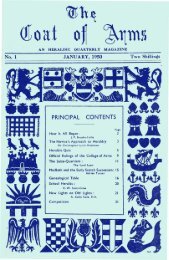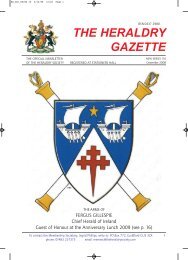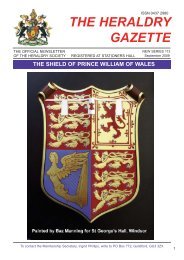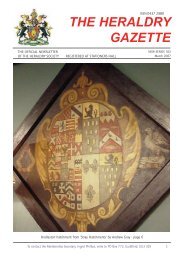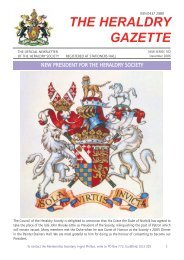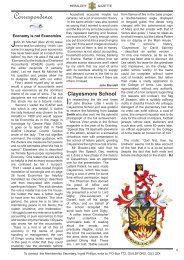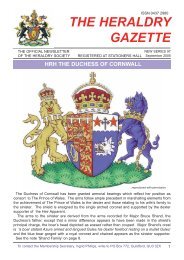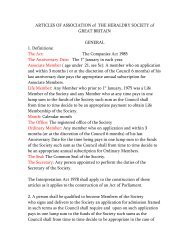You also want an ePaper? Increase the reach of your titles
YUMPU automatically turns print PDFs into web optimized ePapers that Google loves.
THE OFFICIAL NEWSLETTER<br />
OF THE HERALDRY SOCIETY REGISTERED AT STATIONERS HALL<br />
ISSN 0437 2980<br />
THE HERALDRY<br />
GAZETTE<br />
NEW SERIES 100<br />
<strong>Jun</strong>e 20<strong>06</strong><br />
<strong>The</strong> small-scale hatchment prepared by Andrew Gray and illustrated above was displayed at the Anniversary<br />
Luncheon and hung behind High Table. It is now in the <strong>Society</strong>'s possession. It bears a copy of the arms of the<br />
late John Brooke-Little as painted by the eminent heraldic artist, Anthony Wood.<br />
1
2<br />
JOHN PHILIP BROOKE BROOKE-LITTLE Esquire CVO MA FSA<br />
In 1947, an advertisement appeared in Boys' Own<br />
Paper and elsewhere.<br />
A memorable meeting was held at <strong>The</strong> Interval Club,<br />
up stairs of a terrace house in Greek Street, Soho. I was<br />
in the regulation Sunday suit that we wore at school,<br />
stiff collar and heraldic tie of the school where the<br />
great armorists, W.H.St John Hope had been a boy and<br />
Sabine Baring Gould had been headmaster. A welldressed<br />
young gentleman with round steel rimmed<br />
glasses and bow tie, already showing signs of the<br />
baroque figure he was to become, and the beginnings<br />
of a balding pate, introduced himself as John Brooke-<br />
Little. Two ladies, and some learned looking elders<br />
were there to support him. <strong>The</strong>y had great ideas for the<br />
future of the hobby that I had begun more than a<br />
dozen years before. <strong>The</strong>se led to the creation of <strong>The</strong><br />
<strong>Society</strong> of Heraldic Antiquaries to which I paid my first<br />
year's subscription. Copies of a cyclostyled newsletter,<br />
<strong>The</strong> Escutcheon, appeared spasmodically and in a<br />
variety of sizes, edited by Mr Brooke-Little.<br />
<strong>The</strong> Escutcheon graduated from Gestetner to print<br />
and disappeared for a while to be replaced by <strong>The</strong><br />
<strong>Heraldry</strong> Gazette. In 1950, John also launched the<br />
society's journal, <strong>The</strong> Coat of Arms and was its Editor<br />
in Chief for more than 40 years. In the early years his<br />
mother, Constance Egan, was both secretary of the<br />
society and editor of the journal. On visits to our home<br />
she would read her own Epaminondas stories to our<br />
children. One could discern the source of John's quick<br />
wit and sense of merriment, his deep faith and literary<br />
abilities. Indeed, one was soon to recognise what an<br />
amusing turn of mind he had. A humorous and<br />
captivating personality, John was an entertaining and<br />
erudite lecturer and evidently did much through his<br />
talks and tours and his skills as a raconteur to promote<br />
the expanding interest in heraldry throughout the<br />
world. He was responsible for launching several<br />
heraldic congresses that were signal successes due in<br />
large measure to his management of his team of<br />
collaborators. Like our mutual friend, Wilfrid Scott-<br />
Giles, John popularised a subject otherwise regarded<br />
as the study of fools with long memories. Wilfrid and<br />
John became the “Tweedle Dum and Tweedle Dee” of<br />
the world of heraldry, John also succeeding Wilfrid<br />
with editing several editions of Boutell's <strong>Heraldry</strong>, that<br />
became a standard work of reference on heraldic<br />
practice among armorists and the heralds themselves.<br />
He also edited Fox Davies's Complete Guide to<br />
<strong>Heraldry</strong> written in 1909, along with many other<br />
books and articles on genealogy and heraldry.<br />
When the idea of a school for family history studies<br />
was born in 1957, John's signature joined those of the<br />
founders who signed the concord on a large piece of<br />
heraldically decorated wallpaper as suggested by our<br />
great personal friend the late Sir Colin Cole, quondam<br />
Garter King of Arms. As one of the first and a muchappreciated<br />
member of the Court of Trustees of the<br />
Institute of Heraldic and Genealogical Studies in 1961,<br />
the contributions of John Brooke-Little will be sorely<br />
missed. He accepted the role of a Vice-President when<br />
poor health compelled him to resign in 2004. He<br />
proved to be a counsellor of the most remarkable<br />
loyalty, a diplomatic advisor, and, inevitably an<br />
innovator of good ideas for the progress of education<br />
in our field of study.<br />
Though once he had enjoyed riding a motor scooter,<br />
John was not enthusiastic about driving but enjoyed<br />
travelling by train. Apologising sometimes for lateness<br />
in arriving at meetings after we reached Canterbury in<br />
1961, he did not complain that the train had been<br />
diverted via Ashford or Sheppey. He told us that he<br />
enjoyed the sound of the wheels and if in his<br />
alternative life he had not become a priest, he might<br />
well have chosen to become an engine driver,<br />
preferably with steam.<br />
Apart from being known as JBL, it was at El Vino's<br />
in the Strand over glasses of Burgundy, Claret or postprandial<br />
Port, with the aid of Gerald Henderson<br />
sometime Librarian at St Paul's Cathedral, helped by<br />
Colin Cole and the journalist, James Moran, that on his<br />
appointment to the office of Bluemantle Pursuivant,<br />
we christened him “Bluebottle”. That was a name that<br />
persisted beyond his promotion to Richmond Herald in<br />
1967. Much of the progress of the <strong>Heraldry</strong> <strong>Society</strong><br />
was planned in advance of formal meetings of Council<br />
in that hostelry under the watchful eye of the jovial<br />
Frank Bower. A chair emblazoned with the arms of the<br />
<strong>Society</strong>, now sadly worn away, was donated to the back<br />
room of El Vino's. Apart from El Vino's, cognoscenti<br />
among the heralds and armorists were also lured into<br />
“Winnie's" at No. 10, Fetter Lane, off the Fleet, and of<br />
course, to “<strong>The</strong> Horn" behind <strong>The</strong> College of Arms, the<br />
one since demolished and the latter since suffering<br />
from a face lift and a change of name; but in both,<br />
business of <strong>The</strong> <strong>Heraldry</strong> <strong>Society</strong> spun apace.<br />
John Philip Brooke Brooke-Little, was born 6th April<br />
1927, son of the late Raymond Brooke-Little and the<br />
children's author, Constance Egan. He married in<br />
Items for inclusion in the Gazette post to: <strong>The</strong> Editor, <strong>The</strong> <strong>Heraldry</strong> Gazette, at the address given on<br />
page 11, or e-mail to: heraldry.gazette@mac.com
1960, Mary Lee, only child of the late John Raymond<br />
Pierce, and had three sons and a daughter. Educated<br />
at Beaumont House in the Oratory School, Clayesmore<br />
School and New College, Oxford, after a short term on<br />
National Service in Yorkshire, and while teaching for a<br />
short time at a preparatory school, he joined the Earl<br />
Marshal's staff in 1952/3. He was a Gold Staff Officer<br />
for the Coronation in 1953, being appointed<br />
Bluemantle Pursuivant of Arms in 1956. In the<br />
previous year he attended the International Congress<br />
of <strong>Heraldry</strong> and Genealogy in Madrid where he<br />
received accolades for his foundation in England. This<br />
inspired him to promote congresses of <strong>The</strong> <strong>Heraldry</strong><br />
<strong>Society</strong>. He attended the 5th International Congress in<br />
Brussels in 1958 on which occasion he drew heraldic<br />
and other designs in cartoon fashion on Alice's napkin<br />
as well as caricatures on the table-cloth, while merrily<br />
humming. When, as he was wont, he nodded off at the<br />
table over an unfinished meal, I confess that we left<br />
him to his slumbers and found our way back to the<br />
residence, being greeted cheerfully with some apt<br />
remark about the power of Belgian fare before the first<br />
lecture on the following morning. From his own wide<br />
experience, he was particularly helpful to me when<br />
organising the International Congress in England in<br />
1976. Unfortunately there was no answer to the<br />
rampaging inflation of those years.<br />
Although he did have some financial support from<br />
an ancient aunt, John was quick to make a success of<br />
his practice as Bluemantle, and, in 1967, he was<br />
advanced to the office of Richmond Herald that had<br />
lain vacant for nearly six years. He was specially<br />
involved with the late Rodney Dennis, Somerset<br />
A TRIBUTE TO JOHN BROOKE-LITTLE<br />
Herald, in arrangements for the state funeral of Sir<br />
Winston Churchill, and with Sir Anthony Wagner and<br />
the Heralds' Museum. He became Registrar of <strong>The</strong><br />
College of Arms in 1974, and was appointed Norroy<br />
and Ulster King of Arms. He was particularly pleased<br />
because this led, as he often pointed out, to his<br />
appointment as, successively King of Arms, Registrar<br />
and Knight Attendant on the most Illustrious Order of<br />
St Patrick from 1980-1995. He served as Librarian of<br />
the College from 1974-1994, Treasurer from 1978-<br />
1995 and as Clarenceux King of Arms 1995-1997. He<br />
was saddened that his predecessor had insisted on<br />
retaining his office for life while John's was one of the<br />
first appointments to be limited to retirement at the<br />
age of 70. Many a herald survived into his 80's and<br />
beyond.<br />
As prospective bride and groom, John and Mary had<br />
arrived at home to announce their intentions just as<br />
Alice excused herself to give birth to a son, who joined<br />
<strong>The</strong> <strong>Heraldry</strong> <strong>Society</strong> before he was aware of it. John<br />
entertained us with some of his extraordinary and<br />
sometimes hilarious anecdotes as we awaited the<br />
announcement of gender. Aubrey Toppin, John's<br />
predecessor both as Bluemantle and as Norroy was not<br />
far short of 80 when he danced in the courtyard of the<br />
College of Arms with our eldest daughter, Susan, who<br />
was one of Mary's bride's maids when John married<br />
Mary Lee in 1960. To Mary, Clare, Philip, Leo, Merlin<br />
and the family, we offer the heartfelt condolences of<br />
the membership of the <strong>Society</strong> that may probably be<br />
regarded as John's second love.<br />
Cecil R.J.Humphery-Smith<br />
Many contributions by Brooke-Little Norroy and Ulster to the College of Arms, to heraldry and heraldic<br />
education were featured in Daily Telegraph Obituaries 16 February, Times Register 17 February 20<strong>06</strong> and<br />
<strong>Heraldry</strong> <strong>Society</strong> website. Little known but here gratefully acknowledged is the important part he played while<br />
Richmond Herald to save Missenden Abbey (1134 AD) from threat of closure by Buckinghamshire County<br />
Council. Brooke-Little had the ancient arms of the Abbey executed on vellum to increase political awareness of<br />
the importance of the Abbey during the long ‘Battle for the Abbey’, won prior to the 850th anniversary in 1984.<br />
Although the Abbey’s priceless, late medieval roof, 18C roundels and gothic interior were almost wholly<br />
destroyed by arson in 1985, the Abbey’s coat of arms survived and is permanently displayed in the foyer by way<br />
of a lasting tribute to John Brooke-Little, CVO: a lecturer sans égal, a herald sans pareil and, above all else, a<br />
foul weather friend.<br />
Reverend Peter Hebden BA BD PQC(ED)<br />
Warden Emeritus of Missenden Abbey<br />
ON THE NEXT PAGE . . . INFORMATION ABOUT NEW JBL MEMORIAL LECTURES<br />
Items for inclusion in the Gazette: post to the Editor, <strong>The</strong> <strong>Heraldry</strong> Gazette, at the address given on<br />
page 11 or by e-mail to heraldry.gazette@mac.com<br />
3
4<br />
JBL MEMORIAL LECTURES<br />
Council has decided to create a permanent and<br />
ongoing memorial to John Brooke-Little. <strong>The</strong> annual<br />
JBL Lecture will be transformed into a series of lectures<br />
dedicated to promoting heraldry amongst the young.<br />
Ways will be found to have the lectures repeated<br />
before youthful audiences. Council believes that JBL<br />
would have welcomed this.<br />
<strong>The</strong> new JBL Memorial Lecture series will need to be<br />
funded. Some generous donations have already been<br />
made. More would be most welcome. With the<br />
September mailing there will be a flyer inviting<br />
donations to the fund in memory of JBL, with a slip to<br />
submit with your cheque.<br />
CORRESPONDENCE<br />
HERALDRY GAZETTE<br />
<strong>The</strong> High Sheriffs of Oxfordshire<br />
<strong>The</strong> Stadtbrunnen (the town's<br />
fountain) of Bülach<br />
Hugo Brunner’s Shield as High<br />
Sheriff of Oxfordshire<br />
Geoffrey Sampson’s letter in your March issue has<br />
been brought to my attention.<br />
I don’t know whether the fountain in the arms of my<br />
family is derived from our name or from the very fine<br />
fountain in the small town in Switzerland, Bülach,<br />
from which my great-great-grandfather, Johannes,<br />
migrated to Liverpool in 1832.<br />
<strong>The</strong> fountain reminds our family of its professional<br />
roots in water supply. It has helped to keep the<br />
English Brunners in touch with our Swiss cousins,<br />
many of whom visited us when we celebrated the<br />
200th anniversary of the birth of Johannes in 2000.<br />
<strong>The</strong> family motto is nicely ambiguous “Bibe si Sapis”.<br />
We have always taken it to mean “Drink from the<br />
waters of Wisdom”.<br />
As Lord Lieutenant of Oxfordshire I am particularly<br />
looking forward to associating Her Majesty the Queen<br />
in May with the efforts of Churches Together in<br />
Charlbury to raise funds for the provision of 10 wells<br />
in Mali.<br />
Hugo Brunner<br />
William Maving Gardner<br />
Since childhood I have been fascinated with all<br />
things heraldic and have held a fanatical devotion to<br />
true medieval heraldry. Never once in my sixty years<br />
of heraldic art have I been tempted to turn my work<br />
into images akin to photographic realism.<br />
On receiving my latest “<strong>Heraldry</strong> Gazette” for Dec<br />
05, I read with great interest the article “William<br />
Maving Gardner”. In this article were the words that<br />
must curdle the blood of today's experts and heraldic<br />
art gurus.<br />
Speaking of the “medieval heraldic lion”, the article<br />
goes on to say, “full of life, movement and spontaneity,<br />
exuding the lion-like qualities medieval man<br />
attributed to the king of beasts, pure joyful decoration,<br />
one of the most important qualities which heraldry<br />
possesses, and one, it must be said, to which too many<br />
heraldic scholars and antiquarians appear totally<br />
blind”.<br />
Well, well! I am gob-smacked and totally delighted.<br />
Medieval heraldry, pure inspiration, like fresh air!<br />
Ron Douglas Lovell<br />
‘Noble Hearts. <strong>The</strong> Order of St Joachim’ - A<br />
review by Clive Cheesman. Coat of Arms No.<br />
211. Spring 20<strong>06</strong><br />
Mr Cheesman notes that the foreword is by the<br />
Grand Master of the Order, “His Excellency the<br />
Chevalier Col. Prof. V Helmut von Bräundle-Falkensee<br />
. . .” who lives in his native Austria.<br />
Having regard to this impressive description of the<br />
Grand Master, I was disappointed to find no entry in<br />
Rietstap for “von Bräundle-Falkensee”. Likewise there<br />
was no entry (under either name) in the 16 volume<br />
ADELS LEXICON (1972-2005) published by C A Starke<br />
Verlag!<br />
D O FitzHugh<br />
Visit the website at www.theheraldrysociety.com<br />
THE COAT OF ARMS<br />
‘<strong>The</strong> English in the Golden Fleece Group of<br />
Armorials’ by Steen Clemmensen. Coat of Arms<br />
No 211. Spring 20<strong>06</strong><br />
As a non-statistician, I found some of the argument<br />
in this article hard to follow, and I wonder if the<br />
author or someone more statistically literate than I<br />
could answer the following queries:
1) On p.12 it says “one can spot a conjunction of<br />
rhythm and periodicity between ETO and APA , which<br />
is less distinct than any between ETO and BHM”. This<br />
surprised me given that the author states that BHM is<br />
a copy of ETO. Comparing the lists in Table 1, which is<br />
admittedly only a small part of the full list, there are<br />
13 instances where the sequence in ETO matches that<br />
in APA, but 17 where ETO matches BHM. In each<br />
sequence I have ignored the first item, so that, for<br />
example, the ETO sequence 128,129,130 counts as 2<br />
instances and the following sequence, 1<strong>06</strong>,107 counts<br />
as 1. Further, in the Appendix, the match between ETO<br />
and BHM is overwhelming. Most of the matching<br />
sequences come in 5's or multiples of 5 and the last<br />
22 coats in ETO, 146 to 167, are matched exactly by<br />
the coats in BHM, 2049 to 2070. How does the<br />
author's statement follow from these figures?<br />
2) On p.15 it says “thus APA 33 and ETO 30 have<br />
identical blazons and represent the Earl of Pembroke”.<br />
In the Appendix the Earl of Pembroke's arms are<br />
recorded as ETO 29 not 30, although later in the<br />
article the text gives the correct reference. Does this<br />
give rise to other discrepancies?<br />
3) On p.15 the author explains the reading frame<br />
analysis and in Table 2 demonstrates how this applies<br />
when APA is used as the base and ETO as the object.<br />
If I have understood this right the table shows 13 out<br />
of a possible 26 instances (i.e. 1 / 2 ) where the author<br />
of ETO has copied the sequence of APA as it runs<br />
across the opening between a verso page and the<br />
following recto page, and then back to the beginning<br />
of the next line on the verso page. <strong>The</strong> author goes on<br />
to say “A reversal of the reading frame will<br />
demonstrate that APA cannot have derived from ETO”.<br />
With the limited information in Table 1 and the<br />
Appendix it is only possible to test this for one similar<br />
pair of pages, but to me it appears to fall out as<br />
follows:<br />
Allowing for the missing 109 and 110 and applying<br />
the same formula, this would give a result in which in<br />
4 out of a possible 6 instances (i.e. 2 / 3 ) the author of<br />
APA had used the same sequence as if he had had<br />
ETO in front of him. Admittedly this is an incomplete<br />
table but, as it stands, this would surely mean that the<br />
evidence for ETO being the earlier document is<br />
stronger than for APA. Alternatively, the authors of<br />
both documents were following an earlier unidentified<br />
archetype, which is not very different from the<br />
conclusion by Mr. Clemmensen on page 16. I also<br />
appreciate that the numbering of APA and ETO in<br />
Table 1 is different from that in the Appendix and this<br />
complicates matters.<br />
I look forward to being enlightened.<br />
Raymond Crawfurd<br />
INTERNATIONAL ARMORIAL<br />
Member Paul Langan who has recently taken up<br />
permanent residence in Canada's eastern seaboard<br />
province of Newfoundland and Labrador is having<br />
some success with his new venture, the International<br />
Armorial, which is advertised elsewhere in the<br />
Gazette. It is Paul's intention that the<br />
Armorial should become an all-embracing collection<br />
of armorial bearings, both of individuals and<br />
corporations who have received their arms from those<br />
extant granting authorities around the world. <strong>The</strong><br />
arms registered can be either be in colour or black and<br />
white according to the choice of the grantee,<br />
together with a blazon and rationale, as well as any<br />
other background information an individual or<br />
corporation cares to submit. For those interested in<br />
placing their arms upon the armorial, registration is<br />
Please send your letters or articles to the Editor<br />
of the Gazette at the following address:<br />
<strong>The</strong> Head’s House, Fred Nicholson School,<br />
Westfield Road, Dereham, Norfolk NR19 1JB or<br />
by e-mail to heraldry.gazette@mac.com<br />
PLEASE NOTE THE CHANGE OF EMAIL<br />
ADDRESS.<br />
It is appreciated that not everyone has access to<br />
the necessary computer technology but wherever<br />
possible, it would be helpful if contributions<br />
could be sent digitally, e.g. on a CD.<br />
All opinions expressed in the <strong>Heraldry</strong> Gazette are those of the authors and not necessarily those of the Editor<br />
or of the <strong>Heraldry</strong> <strong>Society</strong>.<br />
E-mail the editor at heraldry.gazette@mac.com 5
6<br />
HERALDRY OF NEW LIFE PEERS<br />
Peter Ll. Gwynn-Jones, CVO, Garter Principal King of Arms, follows articles which appeared in<br />
earlier issues of the Coat of Arms with a further selection of the arms of new Life Peers<br />
Baron Bingham of Cornhill (Thomas Henry Bingham) cr 1996, KG 2005,<br />
Kt 1980, PC 1986.<br />
(Baron Bingham of Cornhill, of Boughrood in the County of Powys)<br />
Arms: Per pale Or and Vert per chevron three Ears of Corn slipped and leaved all<br />
counterchanged<br />
Crest: A Griffin sejant erect Vert beaked and holding with both forefeet a Key wards<br />
upwards and outwards Or<br />
Supporters: On either side a Running Duck that on the dexter Vert beaked and legged Or<br />
and that on the sinister Or beaked and legged Vert<br />
Badge: A Running Duck Vert beaked and legged and grasping in the dexter foot a Key<br />
wards upwards and outwards Or<br />
Baroness Buscombe (Peta Jane Buscombe) cr 1998. (Baroness<br />
Buscombe, of Goring in the County of Oxfordshire)<br />
Arms: Azure on a Roundel per saltire Argent and Or a Roundel per saltire Or and<br />
Argent the whole voided and interlaced with a Bendlet per saltire Or and Argent<br />
and a Bendlet sinister per saltire Argent and Or<br />
Supporters: On either side an Otter reguardant sejant erect Argent gorged with a<br />
plain Collar attached thereto a Chain reflexed over the back Or<br />
<strong>The</strong> Arms were inspired by a device in a local church and the otters were a personal<br />
preference. <strong>The</strong> blazon of the bendlets as “per saltire” is arguable as it is always<br />
accepted that charges on a bend are set bendwise unless otherwise stated.<br />
However, this does not apply to lines of division. For example, a bend “per bend”<br />
suggests a bend divided in half lengthwise. It is not blazoned as “per fess” which it<br />
should be if lines of division follow the bendwise rule. If lines of division are thus<br />
exempted from this rule, then Lady Buscombe's bendlets are per saltire and not<br />
quarterly or per cross. Where a bendlet or bend is divided by two diagonals in what might be considered by many as “per saltire” the<br />
problem is resolved by blazoning such as “per saltire bendwise”.<br />
<strong>The</strong> Arms are a pun on Cornhill, the per chevron formation suggesting a hill.<br />
<strong>The</strong> griffin is taken from the Arms used by Gray's Inn and is depicted<br />
holding a key as a punning allusion to his wife's surname of Loxley. Lord<br />
Bingham of Cornhill and his family breed running ducks.<br />
Baroness Finlay of Llandaff<br />
(Ilora Gillian Finlay) cr 2001. (Baroness Finlay of Llandaff, of Llandaff<br />
in the County of South Glamorgan)<br />
Arms: Gyronny Azure and Sable upon a Roundel Argent a Roundel invected of<br />
eight points Gules charged with a Mullet ribbed of eight points throughout Argent<br />
Supporters: On either side a Unicorn Argent armed and unguled Or gorged with a<br />
plain Collar attached thereto a Line reflexed over the back and terminating in a<br />
Ring Gules<br />
Badge: A Roundel invected of eight points Gules charged with a<br />
Mullet of eight points throughout gyronny Argent and Or<br />
<strong>The</strong> roundel and mullet arrangement suggests a poppy seed case<br />
viewed head on. This represents morphine and its treatment of pain, the latter<br />
being the speciality of Baroness Finlay of Llandaff. <strong>The</strong> poppy seed case is placed upon a background of black and blue which is a<br />
further allusion to pain as are the unicorns. <strong>The</strong> unicorn's horn was anciently considered to be an all heal.<br />
Visit the website at www.theheraldrysociety.com
Baron Jones of Cheltenham (Nigel David Jones) cr 2005. (Baron Jones<br />
of Cheltenham, of Cheltenham in the County of Gloucestershire)<br />
Arms: Per pale Gules and Vert three Mice sejant Argent supporting with the forefeet an<br />
Abacus Or<br />
Crest: A demi Black Rhinoceros Vert armed and supporting with the feet a Welsh Triple<br />
Harp Or<br />
Supporters: On either side a Hippopotamus statant erect and with mouth agape that on<br />
the dexter Vert and that on the sinister Gules both tusked and gorged with an Ancient<br />
Crown attached thereto a Chain reflexed over the back Or<br />
Badge: <strong>The</strong> Head of a Hippopotamus caboshed per pale Vert and Gules crowned with an<br />
Ancient Coronet Or<br />
<strong>The</strong> mouse and abacus represent a computer. Hippos and rhino were a<br />
personal preference and the Welsh harp represents both Wales and the<br />
grantee's love of music.<br />
Baron Griffiths of Burry Port (Leslie John Griffiths) cr 2004. (Baron<br />
Griffiths of Burry Port, of Pembrey and Burry Port in the County of<br />
Dyfed)<br />
Arms: Gyronny Argent and Vert on a Celtic Cross Gules between four Escallops flukes<br />
inwards five roundels Or<br />
Crest: Entwined about a Bottle Kiln Or a Dragon wings displayed the body reflexed<br />
over the sinister side with the tail to the dexter Gules langued Or<br />
Supporters: On either side a male Griffin Gules armed langued rayed and holding in<br />
the interior forefoot a Conch shell Or<br />
<strong>The</strong> griffins are a pun on the surname. <strong>The</strong> rest of the Achievement contains elements<br />
from Wales, including the green and white field, and Christianity.<br />
Baroness Shephard of Northwold (Gillian Patricia Shephard) cr<br />
2005. (Baroness Shephard of Northwold, of Northwold in the County of<br />
Norfolk)<br />
Arms: Quarterly Azure and Or three pairs of Ears of Barley in pale Or each pair fesswise<br />
leaved and with slips inwards and conjoined all counterchanged<br />
Supporters: On either side a Hare Azure gorged with a Coronet attached thereto a<br />
Chain reflexed over the back Or<br />
Badge: A Hare's Face Azure in the mouth a pair of Ears of Wheat fesswise leaved and<br />
with slips inwards and conjoined Or<br />
<strong>The</strong>se Armorial Bearings reflect rural Norfolk with blue for the<br />
Conservative party.<br />
Visit the website at www.theheraldrysociety.com 7
8<br />
THE MOST NOBLE ORDER OF THE<br />
GARTER<br />
<strong>The</strong> Queen has been graciously pleased to appoint the<br />
following to the Most Noble Order of the Garter:<br />
His Royal Highness the Duke of York<br />
His Royal Highness the Earl of Wessex<br />
<strong>The</strong> arms of the Duke of<br />
York (left) are:<br />
Arms: <strong>The</strong> Royal Arms<br />
differenced by a Label of<br />
three points Argent,<br />
charged on the centre point<br />
with an Anchor Azure.<br />
Crest: On a coronet of<br />
crosses and fleurs-de-lys a<br />
lion statant guardant or, crowned with a like coronet<br />
and differenced by a label as in the Arms. Supporters:<br />
As with the Royal Arms differenced by a like coronet<br />
and label.<br />
<strong>The</strong> arms of the Earl of Wessex are similar but<br />
differenced by a label of three points argent charged<br />
on the centre point with a Rose barbed and seeded<br />
proper.<br />
Classified:<br />
25p per word -<br />
Box Numbers £1.50<br />
Advertising within the pages of “<strong>The</strong> <strong>Heraldry</strong> Gazette”<br />
whether classified or display is welcomed from<br />
members and others. <strong>The</strong> rates shown for display<br />
advertisements are the popular sizes for monochrome<br />
reproduction. Rates for larger sizes and colour<br />
reproduction may be discussed with the Advertising<br />
Manager.<br />
Enquiries for placing an advertisement or receiving a<br />
quote should be addressed to the Advertising Manager<br />
at either: advertising@theheraldrysociety.com<br />
or his home address<br />
53 Hitchin Street, Baldock, Hertfordshire, SG7 6AQ.<br />
Visit the website at www.theheraldrysociety.com<br />
ADVERTISING RATES<br />
Display:<br />
1/8 page £30.00<br />
1/16 page £20.00<br />
VICE PRESIDENTS<br />
<strong>The</strong> publication in the last issue of the list of the<br />
<strong>Society</strong>'s Vice Presidents has revealed that there were<br />
two appointments, in 1996 and 1998, which did not<br />
make it to the “office copy” list. <strong>The</strong> corrected full list<br />
is now reproduced below, with profound apologies to<br />
the Archbishop and Mr Turner.<br />
<strong>The</strong> Lord High Constable of Scotland<br />
<strong>The</strong> Lord Lyon King of Arms<br />
<strong>The</strong> Chief Herald of Canada<br />
Garter King of Arms<br />
Clarenceux King of Arms<br />
Norroy and Ulster King of Arms<br />
<strong>The</strong> Master of the Worshipful Company of Scriveners<br />
<strong>The</strong> Master of the Worshipful Company of Painter-<br />
Stainers<br />
<strong>The</strong> Master of the Worshipful Company of Glaziers<br />
<strong>The</strong> Duke of Westminster<br />
Simon Scrope<br />
<strong>The</strong> Rt Rev Michael Mann, former Dean of Windsor<br />
Cecil Humphery-Smith<br />
E. N. (Pete) Taylor<br />
Adrian Turner<br />
David Hubber<br />
<strong>The</strong> Most Rev Archbishop Maurice Couve de Murville<br />
Fergus Gillespie, Chief Herald of Ireland
PHOTOGRAPHIC COMPETITION<br />
<strong>The</strong> Photographic Competition got off to a good start last year with some very enthusiastic entries from our<br />
members. Those who took part and were involved enjoyed the competition. If you were hesitant in submitting<br />
an entry last year Council encourages you to do so this year.<br />
<strong>The</strong> arrangements for the Competition will be the same this year. It is open to members, their families and<br />
their friends (who will need to be sponsored by a member). Entries may make use of traditional roll film or digital<br />
images, but any computer enhancement must be limited to standard recognised darkroom practices. Each<br />
competitor may submit two entries, in which case they must be of different subjects, An entry should exemplify<br />
heraldry in its broadest interpretation coupled with photographic excellence displaying artistic merit and<br />
originality.<br />
<strong>The</strong> judging panel will be chaired by the <strong>Society</strong>'s Chairman, Somerset Herald David White. <strong>The</strong> other<br />
members are Corinna Pike, a member of Council, Shaun Curry, a professional press photographer, and Clive<br />
Alexander, who will provide administrative support.<br />
<strong>The</strong> panel will base its assessment of entries upon photographic quality, technical composition, ingenuity.<br />
strength of heraldic emphasis, aesthetic composition and presentation. It will have discretion not to accept<br />
entries which are regarded as unsuitable.<br />
<strong>The</strong> closing date for the submission of entries this year is 30th October 20<strong>06</strong>. An entry form will be enclosed<br />
with the September issue of the Gazette. <strong>The</strong> winner will be notified by post and the results will be published<br />
in the March 2007 edition of the Gazette. <strong>The</strong> <strong>Society</strong> reserves the right to print and publish such of the entries<br />
as it thinks fit.<br />
As reported in the March issue of the Gazette, the<br />
Norfolk County Council was awarded a certificate of<br />
commendation for the use of its arms on new road<br />
signs at county boundaries. <strong>The</strong> certificate was<br />
presented on May 2nd at the Annual General Meeting<br />
of the Council. <strong>The</strong> photograph (right) shows Mr<br />
Patrick Hacon, the newly elected Chairman of the<br />
Council, receiving the certificate from Andy Anderson,<br />
Chairman of the Norfolk <strong>Heraldry</strong> <strong>Society</strong>.<br />
Photo: Alan Howard, Norwich<br />
CORPORATE AWARD PRESENTATION<br />
PERCY VANT Herald with a Difference by Peter Field<br />
<strong>The</strong> deadline for contributions to the next Gazette is 1st August 9
10<br />
THE SOCIETY’S IMAGE COLLECTION<br />
<strong>Heraldry</strong> is a visual art. To appreciate it, to talk about<br />
it, you really need to see it. Which is why the <strong>Heraldry</strong><br />
<strong>Society</strong>'s slide collection ought to be its most valued<br />
resource. But in practice it is underused, and I am only<br />
just beginning to find out why, and what we are all<br />
missing.<br />
A part of the problem is that no-one actually knows<br />
what we have. <strong>The</strong> published catalogue of some 2,500<br />
slides actually represents only half those that have been<br />
systematically numbered, and this 5000 or so is matched<br />
by at least as many uncatalogued and unprovenanced<br />
(and in too many cases unidentified) slides which have<br />
accumulated over the years through gift or legacy.<br />
I am in the process of absorbing these collections into<br />
the catalogue, while revising the detail of its<br />
classification. Already I can deliver the lists in an<br />
electronic form which can be browsed, searched or<br />
sorted, and this catalogue will keep growing. <strong>The</strong> latest<br />
version of the lists can be found on our website at:<br />
www.theheraldrysociety.com/resources/artwork.htm.<br />
Members may borrow slides from this list by e-mailing<br />
me via andrew.gray4@virgin.net.<br />
In the meantime, though, the art of presentation is<br />
moving on. Those attending our London meetings will<br />
have noted that some lecturers are not using slides, but<br />
projecting digital images straight from a computer.<br />
Digital photography is now as cheap as film<br />
photography, and increasingly amateurs and<br />
professionals alike are taking pictures that they will never<br />
need to print. So as a start I have decided never to lend<br />
a slide out without making a scanned copy. This gives us<br />
both a backup and an expanding digital collection, in<br />
fact an Image Library, not just a Slide Library. <strong>The</strong><br />
catalogue will show whether an image is available as<br />
slide, or as an image file, or as both. At a later date it<br />
should even be possible to show "thumbnails" of the<br />
collection - small images which give an impression of the<br />
slide or stored image, so that a lecturer can make a better<br />
informed choice.<br />
But if this exercise has taught me one thing, it is how<br />
little I know. In this and future issues of <strong>Heraldry</strong> Gazette<br />
I should like to share with you some of the “unidentified"<br />
material, confident that a member somewhere will know<br />
exactly what it is.<br />
On this occasion, the slides are from a collection of<br />
Rolls of Arms. Can anyone name the sources? If you can,<br />
contact me via andrew.gray4@virgin.net, or through the<br />
correspondence page.<br />
Andrew Gray, Image Librarian<br />
Visit the website at www.theheraldrysociety.com<br />
Item 1<br />
Item 2<br />
Item 3
Item 4<br />
Item 7<br />
Item 10<br />
Item 5<br />
Item 8<br />
Item 6<br />
Item 9<br />
E-mail the editor at heraldry.gazette@mac.com 11
12<br />
HERALDRY FROM THE COMMONWEALTH - PART ONE - ST JOHN’S<br />
Through my travels around the<br />
British Commonwealth I have<br />
had the joy and privilege to be<br />
able to become immersed in the<br />
heraldry that comes part and<br />
parcel of historic regions. From<br />
the modern high rise buildings<br />
in cities such as Victoria in<br />
British Colombia to the five<br />
hundred year old city of St.<br />
John's Newfoundland, they all<br />
have heraldry embedded into<br />
their culture.<br />
Recently I was able to tour<br />
parts of Canada for 6 months<br />
while on business. During my<br />
trip it occurred to me that I am<br />
seeing, first hand, the use and<br />
type of heraldry that many<br />
people might not be able to see. So I decided to keep<br />
notes of the wonderful examples that I saw and then<br />
when I returned to the United Kingdom to write a<br />
series of articles on the things that have caused me to<br />
gain an even greater interest in heraldry.<br />
In this article I am going to try and share my interest<br />
in the armorial achievements of the oldest city in<br />
North America and the place that John Cabot<br />
discovered for England more than five hundred years<br />
ago, St. John's, Newfoundland.<br />
<strong>The</strong> coat of arms that the city currently uses was<br />
granted on March 1st 1965 by the College of Arms, as<br />
it was not until <strong>Jun</strong>e 4th 1988 that the Canadian<br />
Heraldic Authority (CHA) was formed. <strong>The</strong> Queen, on<br />
advice from the Canadian Privy Council, awarded<br />
letters patient to the then Governor General Jeanne<br />
Sauvé. <strong>The</strong> letters patent stated that "the Governor<br />
General of Canada is to exercise, or provide for the<br />
exercise of all powers and authorities lawfully<br />
belonging to us as Queen of Canada in respect of the<br />
granting of armorial bearings in Canada". With this<br />
power now transferred to the Governor General,<br />
Canada became the first Commonwealth country to<br />
grant arms without the involvement of London.<br />
<strong>The</strong> blazon of St. John's achievement is “Gules a<br />
Paschal Lamb proper between two chief Escallops<br />
Argent a Chief of the last charged with an ancient ship<br />
sail set pennon and flag flying upon Water Barry wavy<br />
proper And for the crest Issuant from a mural Crown<br />
Or a rocky mountain Sable thereon a Lion passant Or<br />
between two roses Gules each<br />
charged with another Argent<br />
barbed seeded slipped and<br />
leaved proper, Mantling Gules,<br />
doubled Argent. On either side a<br />
male figure”. <strong>The</strong> achievement is<br />
clearly seen in the illustration.<br />
<strong>The</strong> reasoning behind the<br />
blazon is truly interesting and<br />
highlights strongly the history<br />
of St. John's and the effect that<br />
Great Britain had on the city<br />
through the years. <strong>The</strong> shield,<br />
which is of the type of the late<br />
13th and early 14th century<br />
style, has two supporters; on the<br />
dexter a mariner of the fifteenth<br />
century holding an Escroll<br />
Argent inscribed with the date<br />
1497 Stable while the sinister is another mariner this<br />
time of the late sixteenth century holding a Escroll<br />
with the date 1583. <strong>The</strong> dexter figure represents a<br />
mariner sailing with John Cabot, with the date<br />
indicating the year he discovered the island of<br />
Newfoundland. <strong>The</strong> sinister is a mariner with Sir<br />
Humphrey Gilbert with the date that he claimed the<br />
island for England.<br />
<strong>The</strong> background to the shield elements follows: the<br />
lower region of the chief represents the city’s<br />
namesake, St. John, by the use of the lamb, carrying<br />
with it a banner of St. George illustrating the strong<br />
connection with England. <strong>The</strong> upper region refers to<br />
the province of Newfoundland's early discoverers and<br />
explorers; again we see that the ship is flying the St.<br />
George cross, another illustration of the connections<br />
with England. Looking closely we see that the crest is<br />
a stone wall representing the civic authority over the<br />
city while the passant lion and roses act as the third<br />
illustration of English involvement. <strong>The</strong> motto of the<br />
city is shown below the compartment and reads<br />
“Avancez” which means “advance”, the meaning of<br />
which has yet to be understood by me.<br />
St. John's, even though it is the oldest city in North<br />
America has had in its 500 plus years of existence only<br />
one grant of arms, the above. As previously mentioned<br />
this was from the English Kings of Arms, with the grant<br />
only entered into the Canadian registry last year on<br />
the 15th March. Finding this surprising I contacted<br />
Bruce Patterson - Saguenay Herald at the Canadian<br />
Visit the website at www.theheraldrysociety.com
Heraldic Authority and was informed that the granting<br />
of arms to Canadian and Newfoundland municipalities<br />
did not start until the 1940s; prior to that date<br />
armorial designs tended to be freely assumed by<br />
municipalities and it is possible that St John's had a<br />
similar coat of arms assumed.<br />
After contacting Helen Miller of the City of St. John's<br />
Archives I was allowed to view the records of the city<br />
regarding their symbols. I found that previous to 1965<br />
the city did in fact have a seal - I was able to read<br />
letters dating back to the early 1900s that clearly<br />
showed that there were in fact two seals designed, one<br />
of which was used.<br />
<strong>The</strong> description of the adopted seal is as follows -<br />
taken from the city records: <strong>The</strong> tincture of the field of<br />
the escutcheon is gules charged with the emblems of<br />
St. John the Baptist, the patron of the city (and of its<br />
two Cathedrals), a paschal lamb with a banner bearing<br />
St. George's Cross - it was under the aegis of Henry<br />
VII, King of England, that Cabot began his voyage of<br />
discovery in the western hemisphere. <strong>The</strong> Paschal<br />
lamb has been used as a Church symbol of the Baptist<br />
from time immemorial. <strong>The</strong> shells or escallops are<br />
emblematic of the Baptist and Christ's baptism in the<br />
Jordan. <strong>The</strong>y are called baptismal shells and are<br />
arranged upon the shield according to the strictest<br />
rules of heraldic propriety. Above the shield is shown<br />
“the narrows” or entrance to the harbour of St. John's<br />
viewed from the city and looking towards the Atlantic.<br />
Important historical landmarks are shown: Fort<br />
Amherst on one side, Chain Rock, the Battery, and<br />
Cabot tower on the other. Cabot's ship the “Matthew”<br />
is shown in the harbour entrance - distinctive of the<br />
tradition held in St. John's that Cabot visited and<br />
named the place.<br />
From time spent in the city I have seen that the coat<br />
of arms is used widely by the city council, being on<br />
display on everything from road signs to the city’s<br />
website with the latter at www.stjohns.ca. We all have<br />
seen dress uniforms with arms on them, but never have<br />
I seen before every local council employee having the<br />
arms on their uniforms; be it police or city council<br />
workers, basically every person to do with the city in<br />
any way, shape, and form wears them. <strong>The</strong>y proudly<br />
adorn the sides of all city council cars and their service<br />
vehicles. As you walk through the city all you have to<br />
do is look up to see the arms flying on the city’s flag.<br />
This was my first stop and I was impressed by what I<br />
found. I think you will agree. What will I find as I<br />
continue my journey around Canada?<br />
Paul J. Langan, M.Phys (Hon), FRAS<br />
Visit the website at www.theheraldrysociety.com 13
14<br />
ALMANAC OF EVENTS JULY TO SEPTEMBER 20<strong>06</strong><br />
Jul 3 Lancashire Members’ Interests<br />
5 Norfolk <strong>The</strong> Hanseatic League Jim & <strong>Jun</strong>e Marriage<br />
Aug 7 Lancashire Heraldic Monsters John Mackie<br />
Sep 4 Lancashire 3 x 10 minute Talks<br />
6 Birmingham <strong>The</strong> Development of Scottish <strong>Heraldry</strong> over the<br />
last 100 years Elizabeth Roads<br />
7 Middlesex AGM<br />
6 Norfolk A Salute to St George Elizabeth Armstrong<br />
13 Yorkshire Annual General Meeting<br />
26 Birmingham <strong>Heraldry</strong> on Wine Bottles - please bring samples<br />
27 Yorkshire Duxbury Lecture: Castle Life in the 21st Century Sir Thomas Ingilby Bt.<br />
?? Somerset Visit to Shrivenham Church, near Swindon Arlene Fisher<br />
Please check details of meetings with the appropriate contact person shown on page 16<br />
Please note that other heraldic events take place. This is not an exhaustive list. If you would like your events to<br />
appear please send details to: heraldry.gazette@mac.com, including in the subject line - almanac entry.<br />
We welcome the following new members:<br />
Dr. M. Kersley Surrey<br />
Dr. R Coultman London<br />
N. Haywood Tallin<br />
J. K. Norton Peterborough<br />
I. Day Milton Keynes<br />
J. F. Miller Suffolk<br />
E. Herbert Northampton<br />
Catherine Turner was a long standing member of the<br />
<strong>Heraldry</strong> <strong>Society</strong> and regularly attended lectures in<br />
London.<br />
She taught History and <strong>Heraldry</strong> for the University of<br />
the Third Age in Bournemouth.<br />
Born in Stapleton, Bristol, her father was a teacher.<br />
She in turn, taught at the Licensed Victuallers School<br />
where she was a housemistress.<br />
Catherine studied Roman dress in detail to ensure<br />
accuracy in school plays.<br />
Later she became a housemistress at St Edmunds<br />
College, Ware, Hertfordshire where she wrote and had<br />
published an illustrated book on the heraldry at the<br />
College. She took a further qualification in heraldry<br />
whilst at St James under the supervision of the vicar.<br />
Catherine was a member of the St James Parish<br />
Church Council and joined in Fellowship and all<br />
church activities; she was an intercessor and lay<br />
reader.<br />
She had a wide range of interests including lace-<br />
MEMBERSHIP NEWS<br />
CATHERINE TURNER 1924 - 20<strong>06</strong><br />
M. Burtscher Oxford<br />
A. Lingen-Stallard London<br />
D. Gelber London<br />
J. Calver Maidstone<br />
A. Leino Finland<br />
L. Fridriksson Iceland<br />
E. Penn USA<br />
T. Powys-Libbe Berks.<br />
making, and she attended Hampshire Agricultural<br />
Show each year. She had a great interest in film and<br />
television ranging from Buffy the Vampire Slayer to<br />
Harry Potter but she was an informed critic of recent<br />
historical films and TV drama.<br />
A valued member of the St James family, she will be<br />
missed by us all.<br />
Ron Broome<br />
PLEASE NOTE:<br />
<strong>The</strong> next deadline for contributions to the Gazette is<br />
1st August.<br />
Visit the website at www.theheraldrysociety.com<br />
FOR SALE<br />
Queens Beasts colourful models, approx 7”, Franklin<br />
Mint set of ten, plus book, Offers - 01527 876485<br />
Schools Arms 3 volumes loose coloured prints by<br />
David Christie-Murray and Dan Escott, Offers - 01527<br />
876485
Visit the website at www.theheraldrysociety.com 15
16<br />
National<br />
RRooyyaall HHeerraallddrryy SSoocciieettyy ooff CCaannaaddaa<br />
www.heraldry.ca<br />
Contact:: John Wilkes,<br />
RHSC,<br />
P.O. Box 8128<br />
Terminal T, Ottawa, ON K1G<br />
3H9, Canada<br />
secretary@heraldry.ca<br />
FFllaagg IInnssttiittuuttee<br />
www.flaginstitute.org<br />
Contact: Michael A Faul,<br />
44 Middleton Road, Acomb,<br />
York YO24 3AS Phone 01904<br />
33 9985 info@flaginstitute.org<br />
HHeerraallddrryy AAuussttrraalliiaa<br />
Regular meetings in Sydney and<br />
Canberra. Occasional meetings in<br />
Melbourne. Contact: Stephen Michael<br />
Szabo, Hon. Secretary,<br />
PO Box 107 LAWSON<br />
NSW 2783 Australia<br />
heraldry_aust@optusnet.com.au<br />
HHeerraallddrryy SSoocciieettyy ooff SSccoottllaanndd<br />
www.heraldry-scotland.co.uk<br />
Meetings held at various<br />
locations. Contact: Charles<br />
Napier, 40 Morningside Drive,<br />
Edinburgh, EH10 5LZ.<br />
SSoocciieettyy ooff GGeenneeaallooggiissttss<br />
www.sog.org.uk<br />
14 Charterhouse Buildings,<br />
Goswell Road, London EC1M<br />
7BA Phone 0207 553 3290<br />
SSoocciieettyy ooff HHeerraallddiicc AArrttss<br />
www.heraldic-arts.com<br />
Contact: John Ferguson, Phone<br />
01737 242 945<br />
WWhhiittee LLiioonn SSoocciieettyy<br />
www.whitelionsociety.org.uk<br />
<strong>Society</strong> of Friends of the<br />
College of Arms<br />
Contact: Roland Symons, 5<br />
Weatherley Avenue, Odd Down,<br />
BATH BA2 2PF<br />
Local<br />
CONTACTS<br />
CCiittyy ooff BBaatthh<br />
Meetings are held at Manvers Street<br />
Baptist Church Halls, Bath. 2.30 pm.<br />
Secretary: Michael Messer, Flat 1, 2<br />
Lower Church St, Bath BA1 1NL. Phone:<br />
01225 42<strong>06</strong>54<br />
BBiirrmmiinngghhaamm aanndd MMiiddllaanndd<br />
Contact: Adrian de Redman,<br />
Phone 0121-608 5496. <strong>The</strong><br />
Group meets 4th Tuesday<br />
(except Aug & Dec) in the<br />
Kingsley-Norris Room, Birmingham &<br />
Midland Institute, 7.15 pm.<br />
CCaammbbrriiddggee UUnniivveerrssiittyy<br />
www.cam.ac.uk/societies/cuhags/<br />
Contact: Derek Palgrave,<br />
Crossfield House, Stanton,<br />
IP31 2DY<br />
DerekPalgrave@btinternet.com<br />
CChheesshhiirree <strong>The</strong> group meets at Townley<br />
Street Sunday School,<br />
Macclesfield at<br />
2.30 pm. Contact: Mr Harold<br />
Storey 2 Orchard Close, Cheadle Hulme<br />
SK8 7ET<br />
Phone 0161 4853786<br />
CChhiilltteerrnnss <strong>The</strong> group meets at various<br />
locations. Contact: John Allen,<br />
Phone 0118 947 8712<br />
EEaasstt MMiiddllaannddss<br />
Meetings are held at <strong>The</strong> Museum, New<br />
Walk, Leicester.<br />
Contact: Miss I M Norman,<br />
Phone 0116 270 6136<br />
GGrreeaatteerr MMaanncchheesstteerr<br />
Contact: Alan Fennely, 16 Paderborn<br />
Court, Bolton, BL1 4TX<br />
Phone 01204 532915<br />
IIssllee ooff WWiigghhtt<br />
Meetings are held at <strong>The</strong> Riverside<br />
Centre, Newport, IOW.<br />
Contact: Roy Middlebrook,<br />
Phone 01983 522079<br />
barbara@bmiddlebrook.freeserve.co.uk<br />
LLaannccaasshhiirree<br />
http://members.aol.com/lancsheraldry<br />
<strong>The</strong> group meets on the first<br />
Monday of each month at St<br />
Stephen’s Parish Centre,<br />
Broadgate, Preston at 7.30<br />
pm. Contact: Chris Ward, 87 Palmer<br />
Road, Blackburn BB1 8BS Phone 01254<br />
53866<br />
chrisward1@btinternet.com<br />
MMeerrsseeyyssiiddee<br />
Philip Jackson, 38 Heygarth Road,<br />
Eastham, Cheshire, CH62 8AE.<br />
Phone 0151 327 3491<br />
MMiiddddlleesseexx Meetings held at the Guide<br />
Hut, Bury Street, Ruislip.<br />
Contact: Mrs Margaret Young,<br />
34 Farthings Close, Eastcote,<br />
Pinner, Middx, HA5 2QR,<br />
Phone 0208 868 8750.<br />
NNoorrffoollkk<br />
www.norfolkheraldry.co.uk<br />
Meetings are held at United<br />
Reformed Church, Princes<br />
Street, Norwich, 7.45 pm on<br />
the first Wednesday of the<br />
month.<br />
Contact: Philippa Sims, 26c Shotesham<br />
Road, Poringland, Norfolk NR14 7LG.<br />
SSoommeerrsseett Contact: Alex Findlater: <strong>The</strong><br />
Grammar House, <strong>The</strong> Hill,<br />
Langport, Somerset TA10<br />
9UP; 01458 250868; email<br />
alex@findlater.org.uk.<br />
SSttaaffffoorrddsshhiirree<br />
Contact: Graham Phillips, 1<br />
Foxleigh Meadows,<br />
Handsacre<br />
Staffs WS15 4TG<br />
Phone 01543 492794<br />
graham@phillips81<strong>06</strong>.fsworld.co.uk<br />
SSuuffffoollkk<br />
Contact: Donald Hunt, 81a<br />
Southgate St, Bury St<br />
Edmunds, IP33 2BJ<br />
Phone 01284 763462<br />
YYoorrkksshhiirree<br />
www28.brinkster.com/yksheraldrysoc<br />
Meetings are held at<br />
Headingley Parish Centre, St<br />
Michael’s Road, Headingley,<br />
Leeds at 7.15pm. Contact:<br />
David Krause, 6 Corrance Road, Wyke,<br />
Bradford BD12 9LH Phone 01274<br />
679272.<br />
Please send items for inclusion to the<br />
Editor.<br />
Published by the <strong>Heraldry</strong> <strong>Society</strong>, Charity Reg No 24156, Reg Office, 53 High Street, Burnham, Slough, SL1 7JX.<br />
Printed by Masterprint Ltd, London, SE18 5NQ


